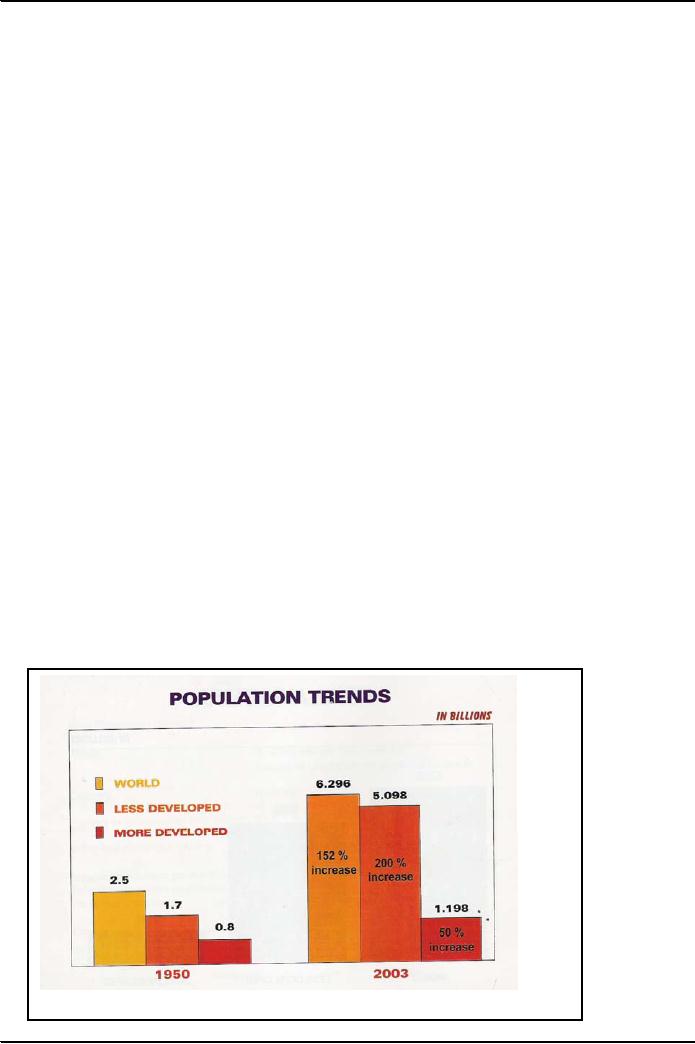 |
POPULATION PROFILE OF PAKISTAN:World Population Growth |
| << THEORY OF POPULATION GROWTH:Theory of Demographic Transition |
| POPULATION PROFILE OF PAKISTAN (Continued):Age Distribution, Sex Composition >> |

Introduction
to Sociology SOC101
VU
Lesson
37
POPULATION
PROFILE OF PAKISTAN
How
does population grow?
Prior
to the discussion of the population
profile of Pakistan let us see
how does population grow? If
we are
looking
at the world population growth
then it is simply:
Births
Deaths in a year per1000
population. Suppose births in a
year are 40 and deaths
are 10 then 40 10
=
30 per 1000 population or
3.0 per cent growth
rate per annum. (Population
growth rate is presented
in
percentages).
For
a country population growth
rate is calculated as:
Births Deaths + (immigration
emigration).
For
a province or district population
growth within a country: Births
Deaths + (immigration
emigration)
+ (In-migration Out-migration).
In-migration and out-migration is the
internal migration
within
the country.
Urban
area population growth
within a country: Births Deaths +
(immigration emigration) +
(In-
migration
Out-migration) + Expansion in the urban
area.
Suppose
the population grows at 3 percent
per annum, what does it
mean?
It
means the population would
double in 23 years. How? The
formula is very simple:
Just
divide 70 years by the rate of
growth: 70/3 = 23
years.
It
may be called LAW
OF SEVENTY.
World
Population Growth
Population
growth trends show that the
world population in 1950 was
2.5 billion which increased
to 6.296
billion
in 2003, showing 152 percent
increase (see fig. 1). In
the less developed countries, during the
same
period,
the population increased from
1.7 billion to 5.098
billion, showing an increase of 200
percent.
Compared
with them in the more developed
countries, during the same
period, the population
increased
from
0.8 billion to 1.198
billion, indicating only a 50
percent increase. These
figures suggest that the
world
population
is increasing very fast; and the
biggest contribution to this increase is
being made by the less
developed
countries.
Figure
1
88

Introduction
to Sociology SOC101
VU
Population
has been growing slowly in the
past. It took thousands of
years for the world
population to
reach
the figure of 1 billion, which
was estimated to be in the year1804
(see table 1). It took
only 123 year
to
add the second billion to the
population of this planet and that
happened in 1927. For the
addition of
third
billion it took only 33
years and that happened in
1960. The population of the
world has been
growing
so fast that for the
addition of fourth billion it
took only 13 years which
was in 1974. For the
addition
of fifth billion it took
only 12 years and that
was in 1987. Within the next
12 years the world
population
has seen the addition of
sixth billion, which
happened in 1999. Presently we
have more than 6
billion
people living on this planet earth and
the population is still growing.
Table
1: Time taken to add one billion to world
population
_____________
.___________________
______Year
World
Population
Years____
1804
1
---
1927
2
123
1960
3
33
1974
4
14
1987
5
13
.
1999
6
12
.
.
In
table 2 it is interesting to note that
the more developed regions have
less population (1198 million
in
2003)
and high GNP/capita ($ 22060
in 2002) compared with less
developed regions (population
5098
million
and GNP/capita of
$3580).
Table
2: Population and GNP/capita
___________________________________________________________________
Population
GNP/
Region
(million)
2003
Capita
($) 2000
World
6296
7140
More
Dev
1198
22060
Less
Dev
5098
3580
Specifically
talking about Pakistan, table 3 shows
that the country has an area
of 0.796 million sq.
kilometers
which
comes to be 0.6 percent of the
world. With respect to
population it had reached an
estimated 151
million
people in 2004 which was 2.4
percent of the world
population.
Table
3: Pakistan: Share of the
World 2004
__________________________________________________________________
Area
0.796
Million Sq. Km.
0.6
%
Population
151
Million
2.4
%
.
.
Information
provided in table 4 shows
that in 2003 the world
population was growing at the
rate of 1.3
percent
and it was expected that it
will take 54 years to double
it population. Since the more
developed
regions
of the world have been
growing at the rate of only
0.1 percent therefore it will
take a very long
period
(700 years) to double its
population. Compared with them the
less developed regions have
been
growing
at the rate of 1.6 percent, therefore
they will take comparatively shorter time to
double their
population
(44 years).
In
2003 Pakistan had a
population of 148.6 million, which
was growing at the rate of
2.06 percent, and it
was
estimated that its
population will double in 34
years. Compared with other
countries in the region like
Bangladesh,
Iran, India, and Indonesia,
Pakistan has higher rate of
population growth, therefore it is
likely
to
take shorter period to double
than the said
countries.
89

Introduction
to Sociology SOC101
VU
Table
4: Population, rate of growth and doubling
time, 2003
________________________________________________________________________
Population
Growth
Doubling
Regions
(Million)
Rate
(%)
Time
(years.)
World
6296
1.3
54
More
Developed
1198
0.1
700
Less
Developed
5098
1.6
44
.
Pakistan
148.6
2.06
34
.
Bangladesh
136
1.7
41
Iran
66
1.2
58
India
1067
1.7
41
Indonesia
220
1.6
44
.
The
population of the country is increasing
quite rapidly. Table 5 shows
that in 1950 Pakistan with
33
million
people was at 14th place in
population rank order of the
countries. In 2004 with 151
million people,
by
surpassing China, India,
USA, Indonesia, and Brazil, Pakistan
was at 6th place in population rank
order of
the
countries. During the last 54
years the population of the country
has increased about five
times.
Table
5: Pakistan's population rank order in
the world
_______________________________________________________________________
.
Year
Rank
Population
(Million)
1950
14
33
.
2004
6*
151
*
After China, India, USA,
Indonesia, and Brazil having surpassed
Japan, Bangladesh,
Nigeria,
Russia,
etc.
Prior
to 1961-71 decade the rate of
growth has been lower than
what has been found in 2004.
One of the
important
reasons was the high death
rate which had been
neutralizing the high birth rate. In
line with the
theory
of demographic transition the death
rate falls earlier than a
decline in the birth rate
and also the death
rate
declines sharply thereby creating a
big gap between the birth
rate and the death rate
resulting in
relatively
high growth rate. Pakistan
has been certainly passing
through demographic transition as
one can
see
a rise in population growth
during the census period of
1961-72 (3.66), then tapering of
during 1972-
81(3.05),
and then further decline
(2.69) during 1981-1998 as
well as during 2003-04 (1.9)
(see table 6).
Table
6: Population growth rate in Pakistan
_______________________________________________________________________
Period
Growth
Rate (%)
.
1951-61
2.45
1961-71
3.66
1972-81
3.05
1981-98
2.69
2003-04
1.90
.
Although
there is some visible declining trend in
the population growth rate,
yet the mere fact that
the
number
of persons being added annually is so
huge that the overall impact
may not be remarkable.
One
could
look at the number of births that
took place during the year
2002. The data presented in
table 7 show
that
in one year 4, 366, 270
births took place which
comes to as 8 births per
minute being added to the
population
of the country.
90

Introduction
to Sociology SOC101
VU
Table
7: Number of births, deaths, and net
addition of population during
2002
________________________________________________________________________
Time
period
No.
of births
No.
of deaths
Net
addition
In
One Year
4,366,270
1,222,000
3,144,270
Per
Month
363,855
101,833
262,
022
Per
Day
11,962
3,348
8,614
Per
Minute
8
2
6
.
Looking
at the number of deaths, there were
1,222,000 cases in the year
2002, which comes to 2
deaths per
minute.
The resultant difference between
births and deaths shows
that every minute 6 persons
and by the
year
3,144,270 persons were being
added to the population of Pakistan.
The addition of 3.14
million
persons
means adding the population equal to the
cities of Multan + Sukkar +
Peshawar + Quetta. For
these
people the government may have to arrange
facilities for their decent
standard of living.
91
Table of Contents:
- THE ORIGINS OF SOCIOLOGY:Auguste Comte, The Fields of Sociology
- THE SOCIOLOGICAL PERSPECTIVE:Society affects what we do
- THEORETICAL PARADIGMS:Salient Paradigms, Critical Evaluation
- SOCIOLOGY AS SCIENCE:Empirical, Verifiable, Cumulative, Self-Correcting
- STEPS IN SOCIOLOGICAL INVESTIGATION:Exploration/Consultation
- SOCIAL INTERACTION:Social Status, ROLE, The Social Construction of Reality
- SOCIAL GROUPS:Primary and Secondary Groups, Reference Group, Networks
- ORGANIZATIONS:Utilitarian Organizations, Coercive Organizations
- CULTURE:Universality, Components of Culture, Symbols, Language
- CULTURE (continued):Beliefs, Norms, Cultural Diversity
- CULTURE (continued):Culture by social class, Multiculturalism, Cultural Lag
- SOCIALIZATION: HUMAN DEVELOPMENT, NATURE, Social Isolation
- UNDERSTANDING THE SOCIALIZATION PROCESS
- AGENTS OF SOCIALIZATION:The Family, The School, Peer Groups, The Mass Media
- SOCIALIZATION AND THE LIFE COURSE:CHILDHOOD, ADOLESCENCE
- SOCIAL CONTROL AND DEVIANCE:Crime, Deviants, Stigma, Labeling
- THE SOCIAL FOUNDATIONS OF DEVIANCE:Cultural relativity of deviance
- EXPLANATIONS OF CRIME:Sociological explanations
- EXPLANATIONS OF CRIME -- CONTINUED:White-Collar Crime, Conflict Theory
- SOCIAL DISTRIBUTION OF CRIME: EXPLANATIONS, Gender and Crime
- SOCIAL STRATIFICATION: INTRODUCTION AND SIGNIFICANCE
- THEORIES OF CLASS AND STRATIFICATION – I:Critical evaluation
- THEORIES OF SOCIAL CLASS AND STRATIFICATION – II
- THEORIES OF CLASS AND SOCIAL STRATIFICATION – III
- SOCIAL CLASS AS SUBCULTURE
- SOCIAL MOBILITY:Structural factors, Individual factors, Costs
- THE FAMILY: GLOBAL VARIETY, Marriage Patterns, Patterns of Descent
- FUNCTIONS OF FAMILY:Reproduction, Social placement
- FAMILY AND MARRIAGE IN TRANSITION:Family is losing functions
- GENDER: A SOCIAL CONSTRUCTION, Gender socialization
- GENDER SOCIALIZATION:Role of family, Gender Stratification
- EXPLANATIONS OF GENDER INEQUALITY:Conflict Explanations, Feminism
- FUNCTIONS OF SCHOOLING:Cultural Innovation, School Tracking
- ISSUES IN EDUCATION:Low Enrollment, High Dropout, Gender Disparity
- POPULATION STUDY AND ITS SIGNIFICANCE:Crude Birth Rate
- THEORY OF POPULATION GROWTH:Theory of Demographic Transition
- POPULATION PROFILE OF PAKISTAN:World Population Growth
- POPULATION PROFILE OF PAKISTAN (Continued):Age Distribution, Sex Composition
- IMPLICAIONS OF POPULATION GOWTH:Additional GDP needed per year
- POPULATION POLICY:Goals of Population Policy, Objectives, Strategies
- ENVIRONMENT AND SOCIETY:Global Dimension, Historical Dimension
- ENVIRONMENTAL ISSUES:Preserving Clean Water, Clearing the Air
- SOCIAL CHANGE:Social change is controversial.
- CAUSES OF SOCIAL CHANGE:Culture and Change, Conflict and Change, Modernization
- MODERNITY AND POST MODERNITY:Cultural Patterns, Post-modernity